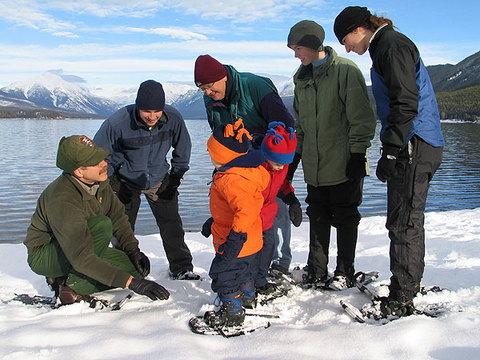Winter is one of the easiest seasons to follow the movements of wildlife in the national parks. Not only can their every move be captured in the snow, but on rare occasions you can follow the interplay between animals.
I'll never forget a trip into the interior of Yellowstone National Park back in January 2001 when a short snowshoe hike up a hillside led us to tracks of a wolf, an elk, specks of blood, bits of fur, and even the delicate imprint of the wings of a raven that had barely touched the snow to sample the blood.
While this snowy canvas was highly unusual, any time spent snowshoeing in the woods, meadows, or shorelines of a park is likely to turn up some signs of what passed by. With that in mind, the rangers at Glacier National Park on January 11 will begin offer twice-daily snowshoe tours on Saturdays and Sundays, conditions permitting, of course.
The tours, which will be offered through March 15, run two hours and are suitable for all ages and abilities. Dubbed "Winter Signs," the tours are intended to show you how Glacier's animal residents survive the cold and harsh months of winter.
The treks are scheduled to begin at 10:30 a.m. and at 1:30 p.m. each weekend day from the Apgar Visitor Center near West Glacier. In the event of severe weather or insufficient snow, individuals should call the visitor center at 406-888-7939 before 12 noon on respective weekend days to confirm that day’s outing.
Snowshoes are available for $2 at the Apgar Visitor Center. Participants may also bring their own equipment. Snowshoes are also available for rent in West Glacier and elsewhere in gateway communities.
These wintertime tours begin and conclude at the Apgar Visitor Center. There is no group size limit and no reservations are taken. Participants should wear sturdy winter boots and dress in layers for varying winter conditions; they should also bring water bottles/devises for personal drinking water.
Park visitors are reminded that although these winter activities are free, valid park entry is required. Even when entrance stations are not staffed, park entrance fees are required. Upon entering the park, visitors are directed to follow posted instructions to pay entrance fees at self-pay stations.
Glacier’s winter entrance fee is $15 for vehicles and $10 for single entrants (hiker/bicyclist/motorcyclist) for a seven day pass. The winter entrance fee is $15 for a seven-day single vehicle entry. Annual park passes, valid for unlimited visits to Glacier National Park for 12 months from the date of purchase, are also available for $35.


 Support Essential Coverage of Essential Places
Support Essential Coverage of Essential Places







Comments
Some of my best days during the time I worked at Glacier were in the winter, and snowshoes are a great way to get out and about in that park during this season of the year.
This is a wonderful idea for a program, and I hope visitors will take advantage of the opportunity.
Glacier NP is one of the best NP i have visited and i have visited over 100 NP. My wife and I go to Glacier when we enter Canada's Waterton National Park just north of glacier. Both parks or a good 17 day stay area. Best time around May, June, July, Cool weather and fantastic beauty.
enjoy it all and visit regularly. If you have an RV and want to travel Canada Dont use the Canadian Interstate. A comparison to the USA roads the Ark. Road are better (if you know the Ark roads.) Use I-90 then enter Canada in Minn. or Wisconsin
Kurt-
Thanks for all the recent articles about winter programs in the National Parks. I wish more of the employees and volunteers guiding these types of introductory trips would consider adding a brief explanation about trying to avoid postholing or snowshoeing in cross-country ski tracks where possible. XC skis can both grip and glide because of wax or "fishscale" patterns under the cambered (arched) center that contact the snow when weighted. Holes in the track can cause the skis to slip and waste quite a bit of energy. This is usually merely annoying to experts, but can be totally discouraging, even dangerous, for novice skiers. I've often seen uniformed Rangers on snowshoes walking side by side where dual tracks already existed. Of course, thoughtless skiers can confuse folks by using the snowshoe track too. At Olympic's Hurricane Ridge, the enlightened staff posts small, temporary signs at the start of the unplowed roads with the non-judgemental message: "Skiers & Snowshoers Please Make Separate Tracks".